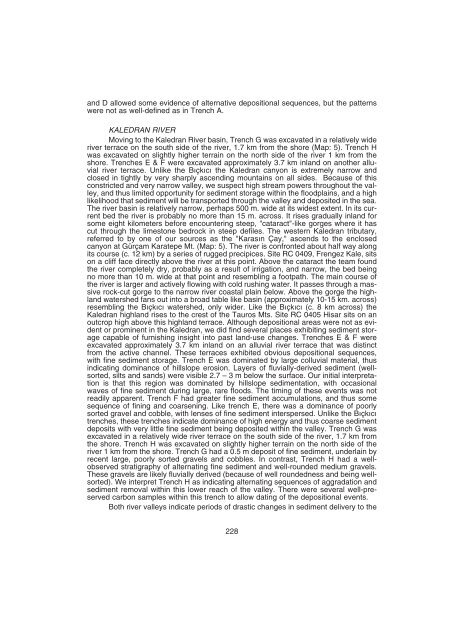23. araÅtırma sonuçları toplantısı 1. cilt - Kültür ve Turizm BakanlıÄı
23. araÅtırma sonuçları toplantısı 1. cilt - Kültür ve Turizm BakanlıÄı
23. araÅtırma sonuçları toplantısı 1. cilt - Kültür ve Turizm BakanlıÄı
Create successful ePaper yourself
Turn your PDF publications into a flip-book with our unique Google optimized e-Paper software.
and D allowed some evidence of alternati<strong>ve</strong> depositional sequences, but the patterns<br />
were not as well-defined as in Trench A.<br />
KALEDRAN RIVER<br />
Moving to the Kaledran Ri<strong>ve</strong>r basin, Trench G was excavated in a relati<strong>ve</strong>ly wide<br />
ri<strong>ve</strong>r terrace on the south side of the ri<strong>ve</strong>r, <strong>1.</strong>7 km from the shore (Map: 5). Trench H<br />
was excavated on slightly higher terrain on the north side of the ri<strong>ve</strong>r 1 km from the<br />
shore. Trenches E & F were excavated approximately 3.7 km inland on another alluvial<br />
ri<strong>ve</strong>r terrace. Unlike the B›çk›c› the Kaledran canyon is extremely narrow and<br />
closed in tightly by <strong>ve</strong>ry sharply ascending mountains on all sides. Because of this<br />
constricted and <strong>ve</strong>ry narrow valley, we suspect high stream powers throughout the valley,<br />
and thus limited opportunity for sediment storage within the floodplains, and a high<br />
likelihood that sediment will be transported through the valley and deposited in the sea.<br />
The ri<strong>ve</strong>r basin is relati<strong>ve</strong>ly narrow, perhaps 500 m. wide at its widest extent. In its current<br />
bed the ri<strong>ve</strong>r is probably no more than 15 m. across. It rises gradually inland for<br />
some eight kilometers before encountering steep, "cataract"-like gorges where it has<br />
cut through the limestone bedrock in steep defiles. The western Kaledran tributary,<br />
referred to by one of our sources as the "Karas›n Çay," ascends to the enclosed<br />
canyon at Gürçam Karatepe Mt. (Map: 5). The ri<strong>ve</strong>r is confronted about half way along<br />
its course (c. 12 km) by a series of rugged precipices. Site RC 0409, Frengez Kale, sits<br />
on a cliff face directly abo<strong>ve</strong> the ri<strong>ve</strong>r at this point. Abo<strong>ve</strong> the cataract the team found<br />
the ri<strong>ve</strong>r completely dry, probably as a result of irrigation, and narrow, the bed being<br />
no more than 10 m. wide at that point and resembling a footpath. The main course of<br />
the ri<strong>ve</strong>r is larger and acti<strong>ve</strong>ly flowing with cold rushing water. It passes through a massi<strong>ve</strong><br />
rock-cut gorge to the narrow ri<strong>ve</strong>r coastal plain below. Abo<strong>ve</strong> the gorge the highland<br />
watershed fans out into a broad table like basin (approximately 10-15 km. across)<br />
resembling the B›çk›c› watershed, only wider. Like the B›çk›c› (c. 8 km across) the<br />
Kaledran highland rises to the crest of the Tauros Mts. Site RC 0405 Hisar sits on an<br />
outcrop high abo<strong>ve</strong> this highland terrace. Although depositional areas were not as evident<br />
or prominent in the Kaledran, we did find se<strong>ve</strong>ral places exhibiting sediment storage<br />
capable of furnishing insight into past land-use changes. Trenches E & F were<br />
excavated approximately 3.7 km inland on an alluvial ri<strong>ve</strong>r terrace that was distinct<br />
from the acti<strong>ve</strong> channel. These terraces exhibited obvious depositional sequences,<br />
with fine sediment storage. Trench E was dominated by large colluvial material, thus<br />
indicating dominance of hillslope erosion. Layers of fluvially-deri<strong>ve</strong>d sediment (wellsorted,<br />
silts and sands) were visible 2.7 – 3 m below the surface. Our initial interpretation<br />
is that this region was dominated by hillslope sedimentation, with occasional<br />
wa<strong>ve</strong>s of fine sediment during large, rare floods. The timing of these e<strong>ve</strong>nts was not<br />
readily apparent. Trench F had greater fine sediment accumulations, and thus some<br />
sequence of fining and coarsening. Like trench E, there was a dominance of poorly<br />
sorted gra<strong>ve</strong>l and cobble, with lenses of fine sediment interspersed. Unlike the B›çk›c›<br />
trenches, these trenches indicate dominance of high energy and thus coarse sediment<br />
deposits with <strong>ve</strong>ry little fine sediment being deposited within the valley. Trench G was<br />
excavated in a relati<strong>ve</strong>ly wide ri<strong>ve</strong>r terrace on the south side of the ri<strong>ve</strong>r, <strong>1.</strong>7 km from<br />
the shore. Trench H was excavated on slightly higher terrain on the north side of the<br />
ri<strong>ve</strong>r 1 km from the shore. Trench G had a 0.5 m deposit of fine sediment, underlain by<br />
recent large, poorly sorted gra<strong>ve</strong>ls and cobbles. In contrast, Trench H had a wellobser<strong>ve</strong>d<br />
stratigraphy of alternating fine sediment and well-rounded medium gra<strong>ve</strong>ls.<br />
These gra<strong>ve</strong>ls are likely fluvially deri<strong>ve</strong>d (because of well roundedness and being wellsorted).<br />
We interpret Trench H as indicating alternating sequences of aggradation and<br />
sediment removal within this lower reach of the valley. There were se<strong>ve</strong>ral well-preser<strong>ve</strong>d<br />
carbon samples within this trench to allow dating of the depositional e<strong>ve</strong>nts.<br />
Both ri<strong>ve</strong>r valleys indicate periods of drastic changes in sediment deli<strong>ve</strong>ry to the<br />
228

















